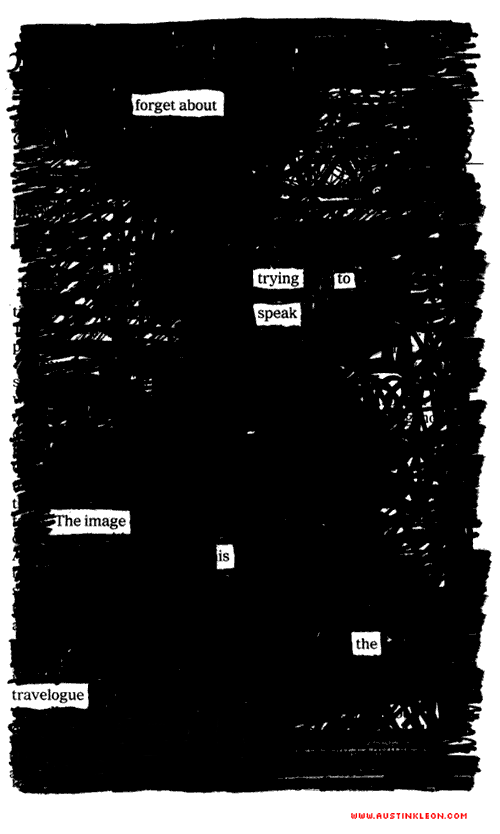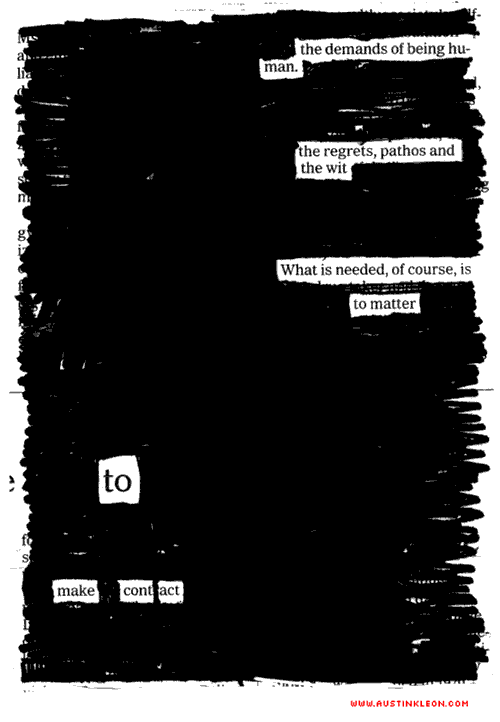
this one is dedicated to lynda barry and her new book which looks amazing
pretty much a paraphrase of this page:

this one is dedicated to lynda barry and her new book which looks amazing
pretty much a paraphrase of this page:

Lots of love for the blackout poems floating around the ‘sphere lately.
Wim Lockefeer (Belgium) wrote a nice little post about them on his excellent blog, The Ephemerist:
Austin Kleon is a cartoonist and poet from Austin, Texas who has a quite original and intriguing way of working. He takes a page from an existing book and blacks out words until he finds a new and hidden meaning in the text, using the block of text as a visual and poetic element, on a par with the actual words….Some of the results are hilarious, some are profound and even unsettling, but they are never bland or boring.
And Greg Wind (Newton, MA) wrote a really flattering post over at Radio Exile:
Part “writing with constrictions,” part happy accident, part found art, part design challenge, the images/poems strike you as a tangible form of indie rock. The materials are easy to find, but making it more than a novelty or parlor trick takes a particularly trained eye and a lot of deep-seated ideas that will find expression through any outlet you make available. The expression subsumes the form….Austin keeps it coming from an honest place, and you can imagine that for every piece that makes it to the site, there are a dozen that couldn’t provide the right word or went in a bad direction. The collection in no order other than chronological gives a well rounded and consistent view into a guy most of us would want to buy a beer (or wouldn’t mind getting this round as long as he’s buying the next).
Big thanks to all you other readers, bloggers, and Stumbleupon folks who support my work! I really appreciate it.
UPDATE (5/8): Jason Kottke linked to the poems, and since then a terrific number of folks have pointed this way. Thanks, everyone!
For those of you reading via RSS, pop over to my homepage real quick and check out the new front page and updated portfolio.
Why the change? I’m hoping that the front page will now be a more friendly portal to newcomers.
For those long-time readers, if you want to skip the frontpage and go straight to the blog, update your bookmarks:
http://www.austinkleon.com/blog/
I should also point out that there’s a new subscription options page. If the blog feed isn’t enough for you, you could always upgrade to the Blog + Tumblelog Superfeed!
And for those of you with eagle eyes, you’ll have noticed a (gasp!) shopping cart. Yeah, it’s just a teaser for now, but one of our projects this summer is trying to get some merchandise up for sale. We want to start small with maybe just some mini-poster prints, and then move on to bigger and better things.
A couple questions:
If anybody has any advice or comments, please let me hear them!
Joe Bageant’s Deer Hunting With Jesus: Dispatches from America’s Class War. Why describe it when dozens of reviewers already have:
Bageant mixes a reporter’s keen analysis, a storyteller’s color, and a native son’s love of his roots in this absorbing dissection of America’s working poor. Returning to his hometown of Winchester, Virginia, after 30 years of life among the elite journalistic class, Bageant sought to answer the question of why the working poor vote for Republicans in apparent opposition to their own interests. (Booklist)
This is a great book. Like Drew Westen’s The Political Brain, it sets out to explain why democrats just can’t capture the hearts and votes of working class America.
There was a particular passage that I thought synced up nicely with Barack Obama’s recent “race” speech, where Obama said:
As imperfect as [Reverend Wright] may be, he has been like family to me. He strengthened my faith, officiated my wedding, and baptized my children. Not once in my conversations with him have I heard him talk about any ethnic group in derogatory terms, or treat whites with whom he interacted with anything but courtesy and respect. He contains within him the contradictions – the good and the bad – of the community that he has served diligently for so many years.
I can no more disown him than I can disown the black community. I can no more disown him than I can my white grandmother – a woman who helped raise me, a woman who sacrificed again and again for me, a woman who loves me as much as she loves anything in this world, but a woman who once confessed her fear of black men who passed by her on the street, and who on more than one occasion has uttered racial or ethnic stereotypes that made me cringe.
These people are a part of me. And they are a part of America, this country that I love.
The passage from Bageant quote concerns religion, but it has the same theme—your people are your people, and they’re a part of you, no matter what:
Only another liberal raised in a fundamentalist clan can understand what a strange, sometimes downright hellish circumstance it is — how such a family can despise everything you believe in, see you as a humanist instrument of Satan, yet still love you and be right there for you when your back goes out or a divorce shatters your life. How they can never fail to invite you to the family’s Thanksgiving dinner.
It must be plain that I do not find much conversational fat to chew around the Thanksgiving table. Politically and spiritually, my family and I may be said to be dire enemies. Love and loathing coexist. There is talk but no communication. At times it seems we are speaking to one another through an unearthly veil, wherein each party knows it is speaking to an alien. There is a sort of high, eerie, mental whine in the air. This is the sound of mutually incomprehensible worlds hurtling toward destiny, passing with great psychological friction, obvious to all yet acknowledged by none.
After a lifetime of identity conflict, I have come to accept that these are my people — by blood, even if not politically or spiritually. I have prayed with them, mourned with them, and celebrated their weddings. I share their rude tastes and humor, and I am marked by the same fundamentalist God-instilled self-loathing. No matter how much I may change or improve my condition, I cannot escape their pathos. I go forward, yet I remain. I wait anxiously and strive for change, for relief from what feels like an increased stifling of personal liberty, beauty, art, and self-realization in America. They wait in spooky calmness for Jesus.
Highly recommended. Thanks to Jessa Crispin for the tip.
Links:
All memory has to be reimagined. For we have in our memories micro-films that can only be read if they are lighted by the bright light of the imagination.
— Gaston Bachelard, The Poetics Of Space
Something weird happens when we try to recreate cultural artifacts from memory: the result has less to do with the artifact, and more to do with us.
A year or two ago I got a Bonnie Raitt song stuck in my head. “I Can’t Make You Love Me.” I had the day off and I was bored, so I decided to sit down with my guitar and try to record the song from memory. I didn’t want to bother learning the lyrics or listen to the original. I just wanted to roll tape and see what happened.
On playback, it was the same song, but it wasn’t. The chords were “off,” and I’m pretty sure I left out a bridge. It’s like the filter of my memory took out the musical complexity and stripped it down to its bones. Left only a “cartoon” of the song…
Here’s the story behind the amazing Dirty Projectors album, Rise Above:
[Dirty Projectors man man Dave] Longstreth went to help his parents move out of the house he grew up in. Among his youthful artifacts was the cassette case from the Black Flag album Damaged. This brought back all sorts of memories— Black Flag was one of Longstreth’s first loves— but the tape itself was missing. So, like the character in the Jorge Luis Borges story ‘Pierre Menard, Author of the Quixote’ who sets out to recreate Don Quixote line by line from memory, Longstreth went to the nearest Guitar Center, purchased the cheapest cassette four-track he could find, and embarked on recasting Damaged from memory, without re-listening to a single note or reading any lyrics. The ten songs that make up Rise Above (titled after one of the tracks on Damaged) stem from these four-track demos, recorded at his parents’ house on an acoustic guitar.
“I had to completely inhabit my early adolescence, the time when I used to listen to Damaged,” Longstreth has said. “[I was] trying to access the memory crystals stored from when I loved it back in middle school.”
The beauty of Rise Above is that Longstreth used his memory of the original Black Flag songs as a starting point to create “new” songs. “I wanted to see if I could make this album…not as an album of covers or an homage per se, but as an original creative act.” It was his imagination that made them great.
It frees us to have constraints. I’m starting to believe that the idea that the artist can should sit down and create something “new” is a paralyzing delusion. We can only create a collage of our influences, our memories—filtered through our imagination.
By re-interpreting these artifacts, we come up with something that is uniquely our own.
Ivan Brunetti has a drawing exercise (link long dead — try his excellent book, Cartooning: Philosophy and Practice) where he has his students doodle cartoon characters quickly, from memory:
When drawing characters quickly, from memory, one can be quite inaccurate, almost as if one is inventing new characters, and these “mistakes” can serve as the basis for new character designs. This lets the students see their own styles more clearly. A page full of these doodles can help the student discern certain qualities that are consistent within their set of drawings. These qualities are a clue as to what makes one’s particular “visual handwriting” different or unique, and these should be embraced by the student.
The idea that by drawing from memory “copies” of other work, we can somehow sharpen our own sense of what makes us unique! I love it.
Links:
This site participates in the Amazon Affiliates program, the proceeds of which keep it free for anyone to read.